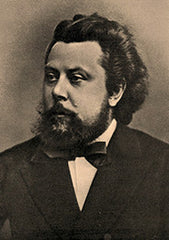Learn About "Pictures at an Exhibition" by Modest Mussorgsky
Pictures at an Exhibition: In Memoriam
Pictures at an Exhibition, by Russian composer, Modest Mussorgsky (1839 - 1881) in the Romantic era, was a piano suite composed in the year 1874. This was written in 10 movements and based on the paintings of Viktor Hartmann, a Russian painter. Mussorgsky and Hartmann were close friends, and the latter’s death in 1873 deeply touched and consequently inspired the composer to write the piece.

Viktor Hartmann’s death had a significant effect on the artistic populace of Moscow. Vladimir Stasov, a critic by profession, honored the deceased artist by setting up an exhibition of his paintings in 1874. This display affected Mussorgsky enough to compose Pictures at an Exhibition, although it was published posthumously, as the composer fell to alcoholism. Nikolai Rimsky-Korsakov, a member of “The Five”, a musical group of which Mussorgsky himself was a part of, edited and corrected the manuscript to publish it in 1886.

Similar to his other works, Mussorgsky’s Pictures at an Exhibition was exposed to the criticism and ‘corrections’ of his contemporaries. They worked toward removing the mistakes in the composition when, in actuality, the original had Mussorgsky’s unique style. It is to be noted that despite having nothing but good intentions, Nikolai Rimsky-Korsakov, made some major changes to the original piece before publishing it. It was the year 1931 when Mussorgsky’s exact composition got published.
The movements in Pictures at an Exhibition attempt to record Viktor Hartmann’s artistic displays in the form of music. A part of the music may have also been based on paintings privately displayed to Mussorgsky by Hartmann. A musical promenade was composed by Mussorgsky, where the artist was himself stated as moving from picture to picture. The promenade acts as a transition between pictures and changing tones.
Ten Movements:
The musical representations of ten of Hartmann’s art pieces are eccentrically mixed with the “Promenade” theme. The ten movements are as follows:
- “The Gnome”, which portrays a dwarf through irregular rhythms.
- “The Old Castle”, which is a grim take on a troubadour singing on castle grounds.
- “Tuileries” is a depiction of playing children at the Tuileries Gardens in Paris.
- “Cattle”, which is a thoughtful projection of a large Polish ox cart.
- “Ballet of the Unhatched Chicks” depicts a work by Hartmann with regard to a children’s ballet.
- “Samuel Goldenberg & Schmuyle”, where the audience can comprehend a shift from loud to a low-profile theme in the conversation between the Jews.
- “The Market at Limoges”, which reminds of folk songs.
- “The Catacombs”, which is wrought with a cold progression of the tune with ominous chords.
- “The Hut on Fowl’s Legs” is dark and horrifying, complete with nightmarish imagery.
- “The Great Gate of Kiev” is the final movement with virtuosic octaves.
The music shifts between 6/4 and 5/4 time, and this results in an irregular metric pacing. This identifies with an art lover moving through a museum, from one painting to the next. The contradictions in the movements are many. From the introspective old-world music in “Il Vecchio Castello” to the chaotic tune of “Ballet of the Unhatched Chicks.” From the pompous beginning of “Samuel Goldenberg and Schmuyle” to the passively menacing style of “The Hut on Fowl's Legs.” We are treated to compositional wonders.
It is a fact that the piece was originally created for the solo piano, but its initial popularity for a long time was in the orchestral form. The most famous version of this modification was arranged by composer Maurice Ravel of France, in 1922. Composers Sir Henry J. Wood in 1918 and Leopold Stokowski in 1939, also played significant roles in making Pictures at an Exhibition famous. In a more modern setting, British rock band “Emerson, Lake, and Palmer” released an album in 1971, with their interpretation of the piece.
The original Mussorgsky version is all about multi-layered music imbibed with energy and vitality. The major requirement for an artist to play Pictures at an Exhibition is to be able to move between soothing melody, humorous tunes and pounding rhythms. In all honesty, Mussorgsky composed some of the best pieces of his time, of which, Pictures at an Exhibition stands out as an achievement in itself, with its wide spectrum of variations.
Reference Links:
- Pictures at an Exhibition by Mussorgsky on Britannica
- Mussorgsky's Picture at an Exhibition on Classical FM
- Modest Mussorgsky on Classical Notes
- Mussorgsky's Picture at an Exhibition on Good Music Guide
Related piano sheet music:
- Mussorgsky's pieces: Piano sheet music at multi-levels
- Music from orchestral pieces: Piano solo sheet music at multi-levels
- Classical music: Piano sheet music at multi-levels
- By Russian Composers: Piano sheet music at multi-levels
- The Great Gate of Kiev: Pick your level - Piano sheet music
- Classical Piano and Keyboard music: Piano sheet music at multi-levels
